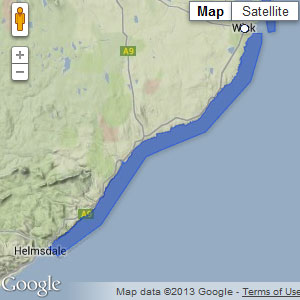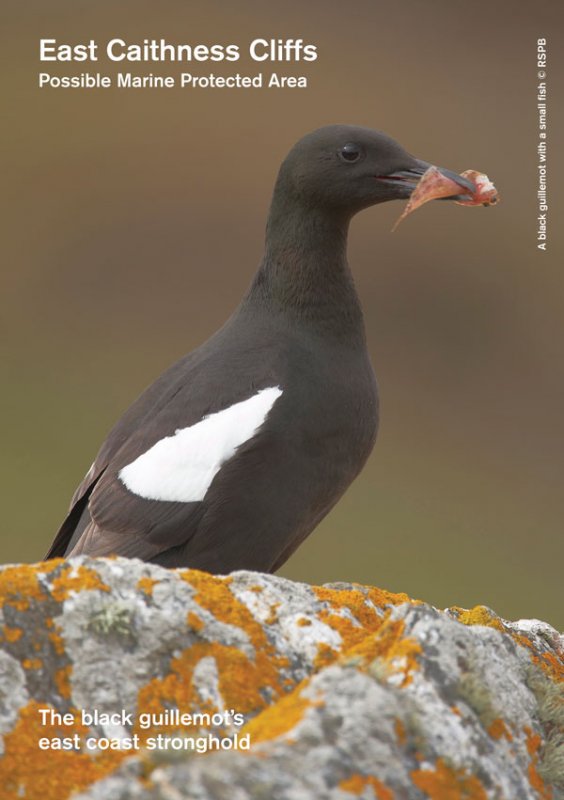 Nearly 1,000 black guillemots, also known as tysties, live on the rocky crevices and ledges of the sea cliffs between Wick and Helmsdale. The East Caithness Cliffs Marine Protected Area (MPA) includes the cliff nesting areas of these striking birds as well as adjacent coastal waters where they feed.[1]
Nearly 1,000 black guillemots, also known as tysties, live on the rocky crevices and ledges of the sea cliffs between Wick and Helmsdale. The East Caithness Cliffs Marine Protected Area (MPA) includes the cliff nesting areas of these striking birds as well as adjacent coastal waters where they feed.[1]
A consultation on proposed management measures for this is expected later this year.
Read our response to the MPA network consultation here:
Save Scottish Seas campaign members have assessed the Scottish Government’s MPA proposal for this site as part of its consultation response.
LINK supports the designation of the East Caithness Cliffs possible Nature Conservation MPA to protect black guillemot populations. The proposed site boundaries hold a significant proportion of Scotland’s black guillemot population and have been established based on scientific evidence endorsed by LINK.
We support the conservation objective of ‘conserve’.Management options:
LINK strongly supports the management option to remove set nets from, or avoid their introduction to, the whole possible MPA site. Should a fishing practice thought to cause seabird bycatch or mortality commence, recommendations from the EU’s Action Plan for reducing incidental catches of seabirds in fishing gears must be adopted (COM(2012) 665).LINK strongly supports the management measure to reduce or avoid the spread of mammalian predators and would strongly support the development of biosecurity plans for the terrestrial breeding habitat adjacent to each of the possible MPAs which include black guillemot as a protected feature. The RSPB shall be developing biosecurity best practice guidelines and will welcome discussion regarding the application of these guidelines within colonies adjacent to possible MPAs.
LINK welcomes the alignment of this possible MPA with the existing East Caithness Cliffs SPA, and suggests that management measures are applied in a way that provides benefits to the entire species assemblage across MPA and SPA.
This site should be considered in the parallel draft seaweed policy statement consultation, particularly with regards to guidance developed for the harvest of wild seaweed.Socioeconomic Assessment:
Costs have been identified in the BRIA which relate to port and harbour activities. However, management of these activities have not been proposed in the management options paper. The link between these must be clarified if these cost estimates are to be used in ministerial decisions about the designation of this site.
The potential value of the East Caithness Cliffs possible MPA to divers and sea anglers has been estimated at £6.7 to £14.1million based on willingness-to-pay measures (Kenter et al., 2013) . Kenter et al. also found important emotional and well-being benefits associated with the East Caithness Cliffs possible MPA, with divers and anglers responding to questionnaire scoring >4 (out of a maximum score of 5) for engagement, therapeutic, transformative and social wellbeing indicator values.Strategic Environmental Assessment:
By establishing biosecurity, this site would also be contributing safeguards to populations of other seabirds breeding along Caithness cliffs. However, unlike black-guillemot, many of these species are in decline nationally. For biosecurity to offer additional benefits to these species, and for the Scottish Government to meet its obligations under the Birds Directive, protection of at-sea feeding areas (beyond colony extensions) will also be required for these birds. Where present, kelp habitats ought also to be protected in this pMPA to support wider ecosystem function, including black guillemot feeding.Check out the official documents relating to the possible East Caithness Cliffs MPA on the Scottish Natural Heritage website.
[1] East Caithness Cliffs MPA site summary page, SNH

